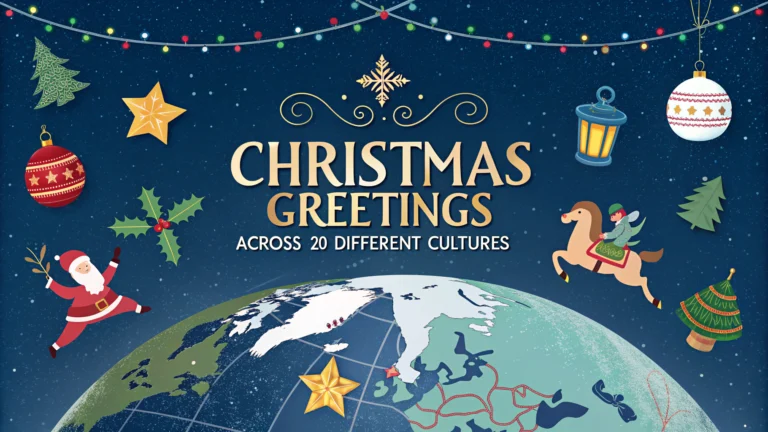Christmas greetings vary wonderfully across different cultures, reflecting unique traditions and local customs that have evolved over centuries.
Common Christmas Greetings Around the World
- English – “Merry Christmas”
- Spanish – “Feliz Navidad”
- French – “Joyeux Noël”
- German – “Frohe Weihnachten”
- Italian – “Buon Natale”
Asian Christmas Greetings
- Japanese – “Meri Kurisumasu” (メリークリスマス)
- Korean – “Meri Krismas” (메리 크리스마스)
- Chinese – “Sheng Dan Kuai Le” (圣诞快乐)
- Filipino – “Maligayang Pasko”
European Variations
- Greek – “Kala Christougenna” (Καλά Χριστούγεννα)
- Russian – “S Rozhdestvom” (С Рождеством)
- Polish – “Wesołych Świąt”
- Swedish – “God Jul”
- Dutch – “Prettige Kerstdagen”
Middle Eastern and African Greetings
- Arabic – “Eid Milad Majid” (عيد ميلاد مجيد)
- Swahili – “Krismasi Njema”
- Afrikaans – “Geseënde Kersfees”
Tips for Using Christmas Greetings
- Learn the proper pronunciation before using a greeting in another language
- Consider regional variations within countries
- Remember that timing of celebrations may differ (some Orthodox Christians celebrate on January 7th)
- Include both religious and secular greetings when appropriate
Common Greeting Combinations
Many cultures combine Christmas greetings with New Year wishes, creating longer seasonal greetings.
| Language | Combined Holiday Greeting |
|---|---|
| Spanish | Feliz Navidad y Próspero Año Nuevo |
| French | Joyeux Noël et Bonne Année |
| German | Frohe Weihnachten und ein gutes neues Jahr |
Writing Christmas Cards
- Address the recipient appropriately based on their culture
- Include both English and native language greetings for international friends
- Consider religious sensitivities
- Add personal touches that reflect the recipient’s cultural traditions
Remember that some cultures might celebrate Christmas differently or not at all, so being mindful of cultural sensitivities helps strengthen international relationships.
Cultural Considerations
Religious Diversity
- Not all countries celebrate Christmas as a religious holiday
- Some regions observe it as a cultural or commercial event
- Consider using “Season’s Greetings” in multicultural settings
- Respect local customs and traditions
Timing of Celebrations
- Western Christmas – December 25th
- Orthodox Christmas – January 7th
- Some cultures celebrate throughout December
- Advent traditions vary by region
Modern Greeting Trends
Digital Greetings
- E-cards with multilingual options
- Social media holiday wishes
- Video calls with international family members
- Virtual celebration platforms
Business and Professional Settings
| Context | Recommended Approach |
|---|---|
| International Business | Use formal, culturally appropriate greetings |
| Corporate Communication | Include inclusive holiday messages |
| Academic Settings | Acknowledge multiple traditions |
Conclusion
Understanding and respecting diverse Christmas greetings enhances cultural connections and demonstrates global awareness. Whether celebrating traditionally or embracing modern customs, the spirit of goodwill transcends language barriers and cultural differences.
When sharing holiday wishes, consider the recipient’s background and choose appropriate greetings that honor their traditions while fostering meaningful connections during the festive season.
FAQs
- What is the traditional Christmas greeting in Spanish-speaking countries?
“Feliz Navidad” is the traditional Spanish Christmas greeting, which literally means “Happy Christmas” or “Merry Christmas.” - How do people say Merry Christmas in German?
“Frohe Weihnachten” is the German Christmas greeting, while “Fröhliche Weihnachten” is also commonly used. - What is the traditional French Christmas greeting?
“Joyeux Noël” is the French way to say Merry Christmas, which is used in France, French-speaking Canada, and other Francophone regions. - How do Italians wish each other during Christmas?
Italians use “Buon Natale” as their Christmas greeting, often accompanied by “Felice Anno Nuovo” for the New Year. - What is the proper Christmas greeting in Japanese?
“Meri Kurisumasu” (メリークリスマス) is the Japanese greeting, which is a phonetic adaptation of “Merry Christmas.” - How do people greet during Christmas in Scandinavia?
In Sweden, they say “God Jul,” in Norway “God Jul,” and in Denmark “Glædelig Jul,” all meaning “Merry Christmas.” - What is the traditional Hawaiian Christmas greeting?
“Mele Kalikimaka” is the Hawaiian way to say Merry Christmas, made famous by the classic Christmas song of the same name. - How do Polish people wish Merry Christmas?
“Wesołych Świąt” is the Polish Christmas greeting, which literally translates to “Happy Holidays,” while “Wesołych Świąt Bożego Narodzenia” specifically means “Merry Christmas.” - What is the Christmas greeting in Mandarin Chinese?
“Sheng Dan Kuai Le” (圣诞快乐) is the Mandarin Chinese way to say Merry Christmas. - How do Greeks traditionally greet during Christmas?
“Kala Christougenna” (Καλά Χριστούγεννα) is the Greek Christmas greeting, literally meaning “Good Christmas.”







